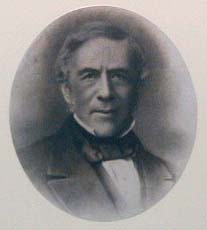
Science writer and historian Nina Morgan on a tale that shows how bureaucracy doesn't rule OK…
Geoscientist 18.5 May 2008
The collection of ornamental stones assembled in Rome during the first quarter of the 19th Century by the Italian lawyer Faustino Corsi, acted as a magnet for the many wealthy culture vultures soaking up history, art and natural history while on a European Grand Tour. And no wonder. Corsi's collection was a particularly magnificent one. It not only included unusually large specimens of polished stone slabs, but was also the first to be arranged and presented in a scientific manner. In addition, Corsi had prepared a detailed printed catalogue to go with it.
When word leaked out (c. 1826) that Corsi was thinking of selling his collection, there was no shortage of interested buyers. Among these were such august institutions as the British Museum.
In 1827, the architect Sydney Smirke (picture, who later in his career designed the Palladian makeover of Old Burlington House) entered into preliminary negotiations to acquire the Corsi collection for the British Museum, and attempted to drive a hard bargain. The British Museum, he said, would be willing to buy part of the collection, at a reduced price. Corsi, unsurprisingly, turned him down.
While the Museum Trustees debated about what to do next, Stephen Jarrett, a wealthy undergraduate at Magdalen College Oxford, made an instant decision to buy the entire collection, along with all remaining copies of the printed catalogue. Jarrett also commissioned Corsi to obtain additional specimens to bring the total up to 1000. When the deal was done, Jarrett donated the collection to Oxford University, where, in November 1827 it was installed in the Radcliffe Library. So all ended happily; especially, perhaps, because it wiped the smirk off the faces of the British Museum Trustees...
Acknowledgement
Thanks to Monica Price of the Oxford University Museum of Natural History, for alerting me to this story.
The sources for this vignette include:
The Corsi Collection in Oxford, by Lisa Cooke and Monica T. Price, in Asmosia 5: Interdisciplinary Studies on Ancient Stone, Hermann, J.J. Jr, Herz, N and Newman, R eds, Archetype Publications, London, 2002 ISBN: I-873132-085, and
Decorative Stone: The complete sourcebook by Monica T Price, Thames and Hudson, London, 2007, ISBN 9780500513415.
The Corsi Collection is now housed in the Oxford University Museum of Natural History. To arrange an appointment to see it, email:
[email protected]].
HOGG
If the past is a key to your present interests, take at look at what the Geological Society History of Geology Group (HOGG) has to offer. A conference,
Dinosaurs -- a historical perspective, organised by HOGG will take place at Burlington House on 5-6 May. For more information about the conference, and all things historical, visit the
HOGG pages.
Highlights currently include: Faujas De Saint-Fond’s Late Cretaceous Marine Vertebrates from Maastricht Rediscovered and Revisited; The discovery of dinosaurs in the Lameta Beds of central India; The “Powerful Imperial Lizard” Dynamosaurus imperiosus; The World’s First Tyrannosaurus rex comes to London; Brontosaurus giganteus: The ”Most Colossal Animal Ever on Earth Just Found Out West” and the Discovery of Diplodocus carnegii; Scientific Priority and Primaeval Monsters; Spinosaurs before Stromer; Early discoveries of spinosaurid theropods and their interpretations; Visualizing Pterosaurs; Life and ideas of Giovanni Capellini: the palaeontological revolution in Italy; Landmarks in the history of dinosaur paleontology in Portugal; The history of Late Jurassic pterosaurs housed in Hungarian palaeontological collections; Before Pteranodon: the early history of gigantic pterosaurs; Allan Jack Charig (1927-1997) An Anecdotal Tribute!; Conan-Doyle, Piltdown, and the dinosaur in the well: obscure Wealden dinosaurs and the stories behind them; Reassessing the Evolution and Origin of Early Birds; Schulz and the earliest discoveries of dinosaurs and marine reptiles in Spain; Lost En Route to England: The 1916 Sinking of the SS Mount Temple and her Canadian Dinosaur Cargo; Pursuing Proavis: art, science and religion in the life and work of Gerhard Heilmann (1859-1946); Dinosaur Ichnology from Portugal; The evolution of sauropod dinosaurs from 1841 to 2008; William Perceval Hunter (1812 1878): forgotten naturalist and author, on both Wealden rocks and dinosaurs-to-be; Pterosaurs – are we making progress?; History of research on Archaeopteryx and the ideas on the dinosaurian ancestry of birds...